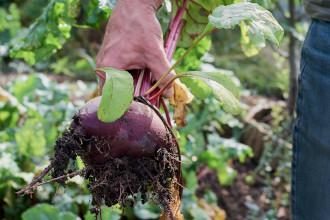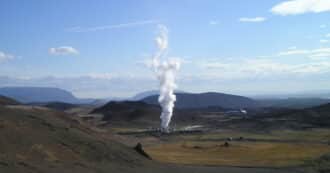By Harry Cooper – Plants are at the center of all life on Earth. They provide us with food, clean our air, and play a part in every ecosystem on Earth.
But, growing plants for agriculture on an industrial scale requires lots of energy and hazardous chemicals. One way that many people used to get around having to rely on industrial agriculture, is through gardening and growing their own food.
A Greener Way of Growing Plants
By growing our own food, we are able to make the choice not to use chemical fertilizers and pesticides or energy extensive farming techniques. One of the more advanced energy saving techniques when gardening is using geothermal greenhouses.
A greenhouse is a small building designed to house plants and let them grow all year round. One of the biggest issues with greenhouses is making sure they stay cool in the summer and warm in the winter.
Heating and cooling greenhouses can be expensive and requires a lot of energy. However, a geothermal greenhouse relies on geothermal heating systems to regulate greenhouse temperatures using only the warmth from the sun and soil.
The Problem With Industrial Agriculture
During the last century, humans have adopted new farming techniques that allow them to grow larger quantities of food. While this has helped combat world hunger, industrial agriculture has come with some unintended environmental consequences.
Chemicals and Excessive Energy
Industrial farming relies on the use of powerful chemical fertilizers and pesticides to grow food. These chemicals often run off into local water supplies and cause water pollution.
Water pollution can have serious effects on human health and the environment. Many of these chemicals are highly poisonous to humans and animals and can increase rates of chronic illnesses.
The agricultural industry is also one of the biggest energy users in the world. It uses about 30% of available global energy, and because most industrial farms are still reliant on fossil fuels, agriculture also accounts for 30% of all greenhouse gas emissions.
This makes industrial agriculture a huge issue. On the one hand it has a huge negative environmental impact, while on the other hand it provides food on a mass scale to a world with an alarming amount of food security.
Growing Your Own Food
Planting a garden and growing your own food is a great way to reduce the impact that industrial farming has on the environment. By not using chemicals, fertilizers, and pesticides or any energy intensive industrial machinery, food grown in gardens has a much smaller impact on the environment.
Along with being better for the environment, growing your own food can also have numerous other benefits. Food grown at home is usually healthier than food bought at the store. Additionally, it is also much cheaper to grow food rather than buying it.
Issues with Growing Food
Growing your own food may seem like a simple solution to avoid supporting industrial agricultural systems. However, growing fruits and vegetables and taking care of a garden are a lot more complex than most people realize.
Taking care of a garden requires careful attention to the plants’ needs, such as water, removing pests, where to plant certain plants, soil quality, etc. Along with this, plants have specific growing seasons, and may not even produce enough food to fully feed someone.
Greenhouses
Using a greenhouse can make it much easier to grow your own food. Greenhouses shield plants from extreme weather and temperatures which makes growing seasons longer, more fruitful, and more reliable. Keeping plants in a greenhouse makes it easier to grow any type of plant.
While greenhouses come with a lot of advantages, they are also very costly. Not only can building a greenhouse be very expensive, but heating and cooling a greenhouse can also be very pricey.
Along with this, heating and cooling greenhouses uses a lot of energy, which is a big environmental problem for industrially grown food. Luckily, there is a sustainable way of regulating greenhouse temperatures that saves money and is better for the environment.
Geothermal Greenhouses
Geothermal energy is one of the many types of renewable energy that could replace fossil fuels. Geothermal energy relies on harvesting thermal energy that is trapped beneath our feet in the Earth’s crust.
On a large scale this requires lots of drilling and expensive turbines. However, harvesting geothermal heat can be used on a smaller scale to regulate greenhouse heating systems.
Collecting geothermal heat from underneath the Earth’s surface may seem incredibly complicated. However, it really only requires a simple geothermal system.
How the Geothermal Systems Work
The main types of geothermal heating systems are air systems. However, there are many other alternative heating systems that also work. Regardless of the specifics of the heating system, the general idea of how they work is the same.
Tubes attached to the greenhouse hold air beneath the ground. In the winter this air is warmed by the geothermal heat in the soil.
When the air in the greenhouse becomes too cold a heat pump, or heat exchanger, replaces the cold air in the greenhouse with warm air in the tubes. The cold air is then left in the tubes to be heated by the soil’s thermal energy, until the plants are ready for warm air again.
Geothermal greenhouses can also keep plants cool in the summer. The system that heats the greenhouse works the same way for cooling.
Since the sun doesn’t reach the pipes underground, the air in them stays cooler than the air in the greenhouse. When the greenhouse gets too hot, the heat pump changes out the air in the greenhouse for the cooler air, and pumps the hot air underground to cool off.
Closed and Open Loop Systems
Some other specific types of geothermal greenhouse heating systems include closed loop and open loop. The difference in these lies in exactly how they heat and cool.
Open loop systems use natural nearby bodies of water or groundwater as a way to cool and heat their pipes. This works very well as water is a very good heat conductor, and can cool and heat the pipes very efficiently.
On the other hand, closed loop systems use an antifreeze solution and water to help regulate the pipes. Closed loop systems are typically not as efficient as open loop systems, as natural water sources can heat and cool more consistently. However, depending on where you put your greenhouse, there may not be access to a natural water source, and a closed loop may be your best option.
The Walipini Geothermal Greenhouse
The Walipini greenhouse also uses geothermal energy, but without having to dig tubes deep into the ground. This greenhouse works by digging it into the ground so it takes advantage of the earth’s heat, but also utilizing a plastic or glass greenhouse roof to take advantage of the sun’s heat. The simplicity of this design drew an Amish farm in Maine to build their own. Now they are reaping a larger harvest with a naturally heated greenhouse, and all while adhering to their Amish beliefs of avoiding modern technology.
As “Garden&Happy” describes “Walipinis were created by a Mormon outreach group called the Benson Institute, to help farmers in Bolivia extend their growing season and maximize productivity. Its creators hoped the earthen greenhouse concept would help struggling farmers find a more efficient and sustainable way to farm”. The Walipini greenhouse is a great example of how using natural resources like the sun and geothermal heat can create a sustainable way to grow food.
* Featured image source







